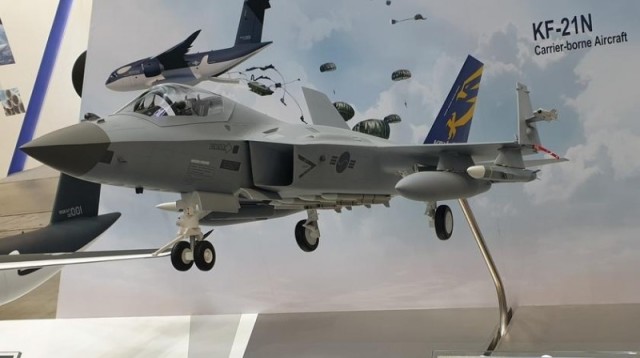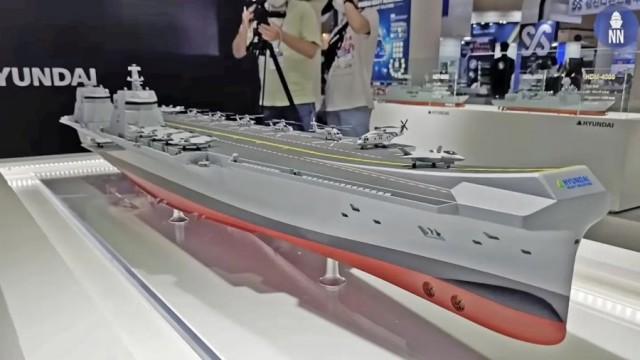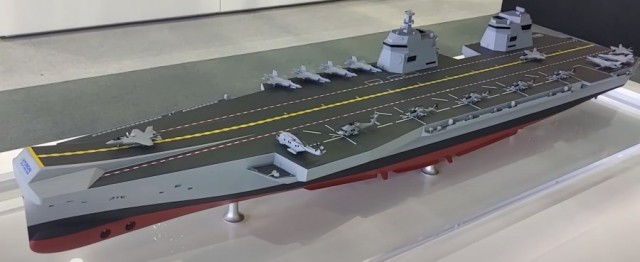As reported by the South Korean television company SBS, the Ministry of National Defense of South Korea has begun to study the possibility of designing and building a large ("heavy") aircraft carrier for the South Korean fleet with an estimated standard displacement of more than 50 thousand tons, instead of the previously planned program for the construction of a light aircraft carrier CVX. A large aircraft carrier can be equipped with a deck version of the promising South Korean fighter KAI KF-21.

The model of the KF-21N deck variant of the promising South Korean fighter KAI KF-21 Boramae, presented by Korea Aerospace Industries Corporation (KAI) at the DX Korea 2022 Defense Industrial Exhibition in September 2022 (c) KAIIt is reported that the Ministry of National Defense of South Korea, in an official response to a request about the fate of the CVX program from a member of the National Defense Committee of the National Assembly of South Korea, representative of the Democratic Party Chong Song Ho, indicated that in March it begins work on a preliminary political study of the possibility of building an aircraft carrier with a displacement of more than 50 thousand tons, instead of implementing a program for the construction of a light aircraft carrier CVX with a specified standard displacement of no more than 30 thousand tons.
A corresponding study on the possibility of creating a South Korean large ("heavy") aircraft carrier and the necessary technologies for it should be completed by the end of 2023, after which a political decision should be made on the final rejection of CVX and the possibility of building a large aircraft carrier.
The response states that this decision of the Ministry of National Defense of South Korea was made after a thorough study of the Defense Acquisition Program Administration (DAPA) completed in January 2023, in which DAPA concluded that the development of a deck version of the promising South Korean fighter KAI KF-21 Boramae (referred to as KF-21N) is quite achievable with sufficient budget allocations and time spent on development - which is estimated at 1.8 trillion won (approximately $ 1.3 billion) and ten and a half years, respectively.
The KF-21N carrier-based fighter should carry out horizontal takeoff and landing (although it is not yet clear whether it is planned to use a catapult or springboard takeoff for it), and, accordingly, its basing on an aircraft carrier will require an increase in the size of the flight deck and the ship as a whole - which determines the minimum required standard displacement of an aircraft carrier of 50 thousand tons.
Recall that in February 2021, the South Korean Ministry of National Defense and DAPA at a meeting of the joint Committee on Defense Procurement programs approved a program for the creation and construction for the South Korean Navy in the period 2022-2033 of the first South Korean "light" aircraft carrier under the designation CVX, with a specified standard displacement of 30 thousand tons. In fact, the previously approved program for the construction of a new large aircraft-carrying universal amphibious assault ship LPH-II has been transformed into this project.
The CVX aircraft carrier was scheduled to be commissioned in 2033. The cost of designing and building the CVX aircraft carrier was approved by the Committee for Advanced Defense Projects at 2.03 trillion won ($1.87 billion). This amount was then increased to 2.6 trillion won ($2.34 billion). In addition, about 3 trillion won ($2.7 billion) was planned to be allocated for the acquisition of an air group for the ship, the preliminary composition of which was set at 20 American fighters with a shortened takeoff and vertical landing Lockheed Martin F-35B Lightning II and eight helicopters.
CVX ship designs were created on a competitive basis by two major South Korean shipbuilding corporations Hyundai Heavy Industries (HHI) and Daewoo Shipbuilding and Maritime Engineering (DSME), which merged, respectively, with the British Babcock International group and the Italian Fincantieri association.
However, the CVX advance projects of both competing groups presented at the MADEX-2021 exhibition in Busan in June 2021 showed that the designers obviously exceeded the tasks in terms of the size of the ships. DSME presented an advance design of an aircraft carrier with a standard displacement of 45 thousand tons, the largest length of 263 m and a width of 46.5 m. The ship should have a two-island superstructure, a rectangular flight deck and be deprived of a springboard, while it should carry up to 28 F-35B aircraft and several helicopters. In turn, HHI presented a very futuristic-looking advance design of an even larger aircraft carrier already in 60 thousand tons, with a maximum length of 270 m and a width of 60 m. The ship should have "stelsized" contours of the surface part, including a two-island superstructure, a springboard in the bow and a corner deck (which, however, does not seem to have functional significance for takeoff and landing).
The CVX program enjoyed the active support of the Democratic President of South Korea, Moon Jae-in, who was in power. However, in the elections on March 9, 2022, the conservative candidate Yun Seok-yel from the People's Power Party was elected the new president, who subjected the CVX program to considerable criticism, and as a result, South Korean plans to build an aircraft carrier turned out to be completely "hung up" for the last year. However, now it seems that a new turn in the case of the South Korean aircraft carrier may occur, based, perhaps, on the increased attention of the new administration to the program of the South Korean national aircraft industry, including its current "flagship product" - the KF-21 fighter.
The negative attitude of Yoon Sok Yeol and the "Forces of the People" to the CVX program was reportedly based, among other things, on "learning lessons from the humiliating failure of Russian troops in Ukraine," in connection with which Yoon Sok Yeol, instead of expensive ambitious military projects, proposed to focus on strengthening intelligence capabilities, increasing the development and procurement of missile and precision weapons. weapons, air defense and missile defense systems, as well as on improving the combat training of troops and the maintenance, maintenance and repair of available military equipment.
According to South Korean observers, the "key" to the "political study" of the Ministry of National Defense of South Korea is how much the cost of the program and the duration of the construction of a heavy aircraft carrier will increase compared to CVX. It should be noted that, given that the CVX advance projects already mentioned have reached a tonnage of 45-60 thousand tons, it seems that the real increase in the cost of the program may not be so great. It is no coincidence, as reported, Hyundai Heavy Industries and the developer of the aircraft Korea Aerospace Industries (KAI) believe that there will be no significant change in the duration and cost of the project, even if a requirement is put forward to ensure the basing of KF-21N aircraft on the aircraft carrier.


A model of the advance design of the promising South Korean "light" aircraft carrier CVX, presented by Hyundai Heavy Industries Corporation (HHI) at the MADEX-2021 exhibition. The ship with a standard displacement of about 60 thousand tons was presented with the basing of American fighters with a shortened takeoff and vertical landing Lockheed Martin F-35B Lightning II. Busan (South Korea), June 2021 (c) www.navalnews.com and bemil.chosun.com
